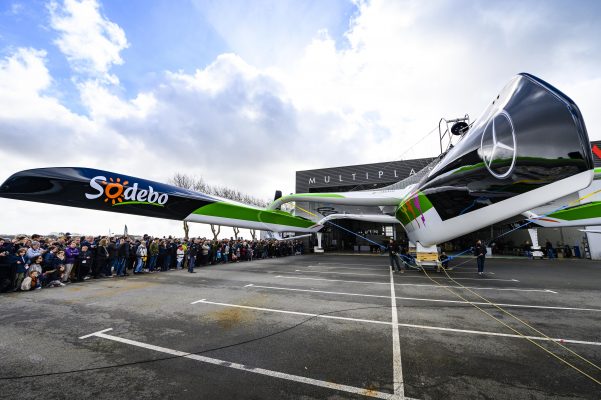“We’d all had this conversation for two weeks, and one of the guys said: ‘Thomas would you actually accept to live there, in the centre of the boat going around the world?’ There was a big silence.”
But his backers, Sodebo, were wholly committed to it from the outset. While the design is brave, the finances of the project are relatively conservative. Coville reveals that his sponsorship model has always been to sell the previous boat for 50% of the value of the next – so his record-breaking Sodebo was sold for €5 million, the build cost of the new Ultime is €10 million.

Including the new boat and running costs, he says Sodebo will have invested €2 million per year over five years – a surprisingly modest fee for a project of such scale and a fraction of the budgets of the Gitana and Banque Populaire teams.
Assuming the new design gets up to speed quickly, Sodebo will get plenty of exposure from their investment. The boat has a packed programme, taking in three round the world tours – including a bid to regain the solo record, and a Jules Verne attempt as well as up to 14 transatlantics over the first four years of its life.
Following the cancellation of the Brest Oceans Race scheduled for this year, I asked Coville was he disappointed or relieved that the Ultime schedule has changed so radically since his design went into build?
“For us it’s more chance, to be honest, because if we had to go around the world this year by myself it would have been tricky. And actually we will have 6 transatlantics, two racing this year, which is a bit softer [introduction].”
Currently there are plans for a crewed Atlantic race from Cape Town to Rio this year, and then a crewed around the world race fro Nice in 2021 – which Coville hopes will attract seven Ultimes. The Brest Oceans solo around the world race is now slated for 2023.

He is confident the new generation of boats will be going around the planet in under 40 days. In practical terms, to cover Gabart’s slightly shorter record track in 39 days would require an average speed of a breath-taking 29.7 knots (there was just 540 miles difference in the distance sailed between the two records).
Maintaining concentration at those speeds has become one of Coville’s biggest focuses – he tells me about a training exercise he does where he works at a high capacity on a rower or treadmill, while having to count and remember the number of ‘t’s or another letter in a passage of text.
Coville also experiences synaesthesia – the phenomenon of sensing a smell, action or taste as a colour. “For me 30 knots is a colour, and a movement and a position, and it’s also a sensation,” he explains.
He also experiences synaesthesia ashore – particularly when listening to classical music, one of his other great passions. He doesn’t listen to classical music while sailing, finding the two occupations both too immersive to be done at once. While synaesthesia is linked to improved memory and concentration, Coville tells me that it can also be overwhelming and exhausting – a constant bombardment of the senses. And, he adds, his kids are well practiced at spotting when his brain has wandered off onto another plane.
“They’ll say ‘Dad, Dad, stop it!’ when they feel like I’ve stopped being in the conversation.”
Recovery is another key focus, and one closely linked to his partnership with Helly Hansen. Getting wet from waves is much less of a focus than having kit which is breathable and avoiding skin infections. Some of the kit he demonstrated in Oslo has physical zips to vent moisture, such as Helly’s H2Flow jacket, rather than relying on multi-layer fabrics for breathability. Coville has worked with Helly for over 12 years, and his very open approach and the famous Scandinavian directness are clearly a good fit.
Where Coville has previously guarded his privacy, he recently made the above film for Helly Hansen featuring his wife and family, which explored the impact his career has on them. Coville says it triggered some interesting conversations with his children – who have always known the risks of what he does, and accepted them, but rarely discussed them.
When I ask him what might one day make him hang up his sea boots, however, it is not the risk that springs to mind. “If I ever stop being curious,” he says, “then it will be time to stop.” No sign of that happening any time soon.




